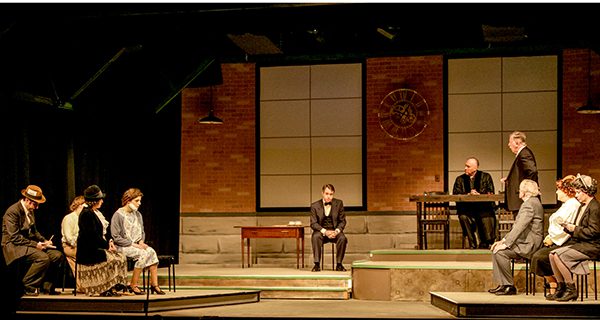[ccfic caption-text format="plaintext"]
By Laura Drinan
Hometown Weekly Reporter
Imagine it’s the 1920’s and at the age of 15, you abandon your studies to earn money at a factory job. The work is easy, the pay is phenomenal, and the other girls in the factory make the time pass quickly with their chatter and antics. You touch a paintbrush to your lips to make a point, dip the small brush in a mixture of radium powder and adhesive, and paint the dials of watches, repeating the process throughout the course of the entire day. You work quickly, but efficiently. After all, those watches will be going to the soldiers in the military and they’re counting on your precise work to be able to see their dials in the dark.

The Walpole Footlighters depict the hearings against the U.S. Radium Corporation in their performance of 'Radium Girls.' Photos by Dan Busler Photography
While some criticized the show for being too depressing and ending without proper justice for the “radium girls,” it successfully shed light on an issue that was frequently overlooked in the 1920s, as the play is based on a true story.
The script itself is compelling enough to keep the attention of the audience, but the Footlighters’ work on the set and costume design brought it to life.
The crew’s tireless work to create the interior of a factory remained on stage throughout the entire show. On the brick painted wall, a large luminous clock became the focal point as it hung between two pendant lamps and two large windows. The set furnishings were simple, but spoke to the working class of the era.
For scenes in Grace’s home with her mother (played by Ninette Cummings) and fiancé Tom (played by Joe Rich) and at the home of U.S. Radium Corporation President Arthur Roeder and his wife, Diane (played by Mark Adams and Shelley Wood, respectively), the crew created panels to place behind the actors during the scenes, dimming the lights that focused on the factory background.
The same technique was used for scenes at the doctor’s office with another victim, Kathryn Schaub (played by Finley Smith) and at the office of Raymond Berry (played by Paul Campbell), Grace’s attorney.
The simple set design proved to be effective in keeping the story fast-paced, as lengthy scene changes were not necessary.
The members of the cast, which also include Cynthia Small, Woody Farrick, and George Motley, took on the roles of multiple characters to produce the powerful play.
The Footlighters will be performing “Radium Girls” until February 18, with tickets available to order online, by phone, or by mail.






















